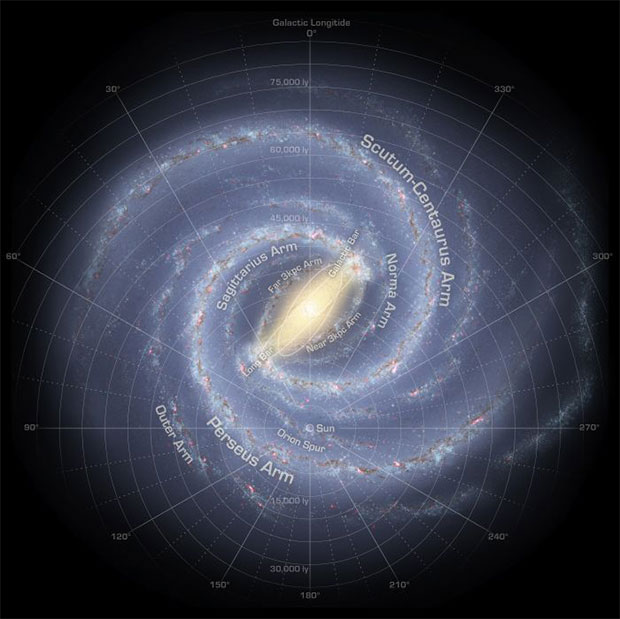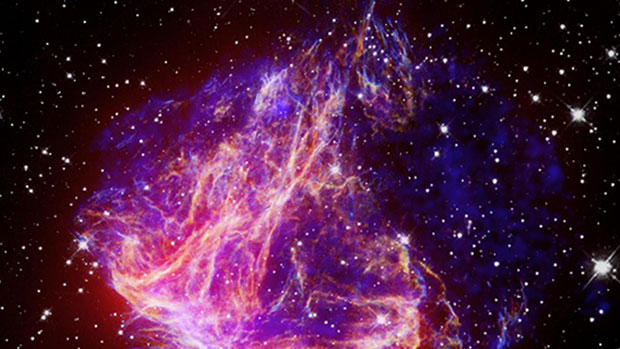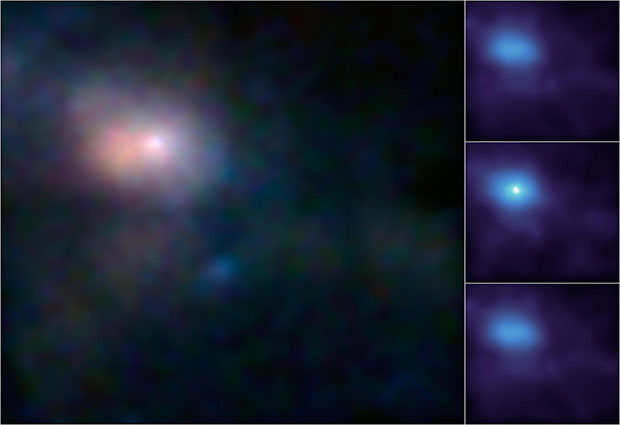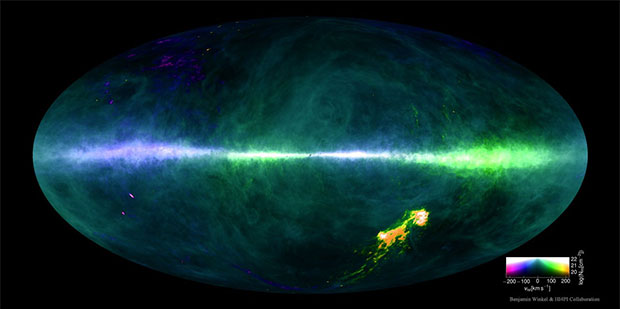Starry starry night: looking up at the Milky Way
Expert reviewers
Professor Naomi McClure-Griffiths
Research School of Astronomy and Astrophysics
The Australian National University
Essentials
- The Milky Way, a barred spiral galaxy that contains between 200 and 400 billion stars, is on a collision course with another galaxy.
- Interstellar gas, most of it hydrogen, accounts for around 5 per cent of the galaxy’s mass.
- At the centre of the Milky Way is a supermassive black hole that consumes stars and interstellar gas and dust.
- We use telescopes capable of measuring various wavelengths of the electromagnetic spectrum to explore and investigate the Milky Way, and the galaxies beyond.
Within the vast expanse of the observable universe’s 2 trillion or so galaxies, the Milky Way is our home, our spot in the sky.

We see our Milky Way every time we look up into the sky on a clear night, a collection of stars that forms the band of light the early astronomers likened to the colour of milk.
Galaxies are collections of stars, clustered together kind of like islands in a sea of space. Some galaxies are bigger than others, and they come in a number of different shapes. Our Milky Way is a barred spiral galaxy, which means that if we could see it from above (which we can’t because we’re embedded in the middle of it!) we would see ‘arms’ spiralling around and around a central point, in a pinwheel shape.
Exactly why and how the stars in spiral galaxies form these arm shapes winding around a centre is not totally understood. The current theory is that the arms are formed as stars pass through density waves during their orbit around the centre of the galaxy. The density waves force the stars into clusters as they pass though, which form the spiralling arm shapes.
The Milky Way has two major arms, called Sagittarius and Perseus. There are also two minor arms, and two smaller ‘spurs’. Earth, its sun, and the rest of our solar system, is embedded within the Orion spur.

How big is the Milky Way?
The total diameter of the Milky Way is around 122,000 light years (a light year is the distance light travels in one year, equal to 9.5 x 1012 kilometres) and it has a thickness of around 1000 light years. By contrast, the largest known galaxy, called IC 1101, is around 4–6 million light years in diameter.
So while the Milky Way is no giant in terms of distance from one side of the galaxy to the other, with regard to mass, the Milky Way is not a bit player—our galaxy’s mass is around 600 billion times that of the Sun.
And we’re certainly big compared to some of our nearest neighbours. The Large and Small Magellanic Clouds, two nearby dwarf galaxies, are much smaller. The Large Magellanic Cloud is only around 14,000 light years across, and the Small Magellanic Cloud a measly 7000 light years across. They are both less than one tenth of the mass of the Milky Way. That said, the mass of the Large Magellanic Cloud is still around 10 billions times that of the sun, and the Small Magellanic Cloud is around 7 billion times as massive as the sun.

What’s in the Milky Way?
The Milky Way contains between 200 and 400 billion stars, of a range of different sizes, intensities and ages.
In amongst all these stars, there’s also a lot of gas and dust floating around. Interstellar gas makes up around 5 per cent of the Milky Way’s mass. Nearly 9 out of every 10 atoms of interstellar gas are hydrogen (H), and it accounts for around 70 per cent of the interstellar gas mass.
And hydrogen is very important! It is the basic feedstock for star formation, which occurs when dense clouds of interstellar gas coalesce and fuse together to create new stars. Hydrogen is also relatively easy to ‘see’ in space, and we use observations of hydrogen to track the distribution of matter throughout our Milky Way, and other galaxies beyond.
The rest of the interstellar gas is made of heavier elements, mostly helium (He), and even some molecules of carbon dioxide (CO2) ammonia (NH3) and formaldehyde (CH2O). The interstellar dust is made of heavier, more complex molecules. The dust is responsible for dark patches we can see within the mass of stars in the night sky.
At the centre of the Milky Way is what’s called the Galactic Bulge, a region densely packed with stars, dust and gas. Right in the middle of the Galactic Bulge is an immense black hole, called Sagittarius A*. This black hole is orbited by stars, gas and dust, all zooming around it at speeds of hundreds of kilometres per second. Black holes can’t be seen directly, so their size is determined by measuring the time it take for stars to orbit around them. Sagittarius A* is thought to have a mass of around 3 million times the mass of the sun. Sagittarius A* is currently thought of as 'dormant' as it hasn't consumed very many of stars and other material orbiting it during the past few million years.

How do we study the Milky Way?
We’re stuck deep within the Milky Way, so it’s impossible to get a view of the galaxy from the outside. All we can do is peer out, and look at other galaxies to give us an idea of how our own works. All the images we have of the Milky Way as a galaxy are merely artists’ impressions—very educated guesses as to what our galaxy looks like.
These educated guesses come from making observations and then using the laws of physics to understand what they mean. For example, the mass of the Milky Way is obviously not calculated by dumping the galaxy upon a set of scales! Researchers measure the rotational speed of stars in the outer regions of the galaxy and use the laws of gravity to figure out their mass.
Similarly, figuring out how many stars there are in the Milky Way involves some educated guesswork—we can’t go out there and count all the stars, one by one, so we estimate the total number of stars by taking the mass of the galaxy, then calculating how many stars are required to give the galaxy that mass.
'Looking' through the electromagnetic spectrum
Just as there’s a limit to what we can see with our naked eyes, there’s a limit to how much of the Milky Way galaxy we can see using the visible light wavelength of the electromagnetic spectrum. Visible light can’t penetrate the dense accumulation of stars and gas that is found in the Galactic Bulge, so to probe the galaxy’s deep structure we need to use measurements of multiple different wavelengths of radiation within the electromagnetic spectrum. There are instruments around the world built to measure radiation on the gamma, X-ray, infra-red and radio wavelengths, which are capable of passing through the thick dust clouds.
Peering in between stars
The Spitzer Space Telescope is a space-based telescope that was launched in 2003. It orbits around Earth, peering out at the Milky Way and through it to the galaxies beyond. It observes radiation in the infra-red wavelength of the electromagnetic spectrum, enabling us to see the heat emitted by new stars forming.
And it’s not just the stars that are interesting to look at! Images from the GLIMPSE survey and the citizen science Milky Way Project have identified bubbles of gas that surround large stars within the galaxy. These bubbles are formed by solar winds—the energy emitted by massive stars ‘blows’ holes into the interstellar gas.
NASA’s Chandra X-ray Observatory is another satellite telescope. It has been measuring radiation within the X-ray wavelength in our galaxy since its launch in 1999. It sits in a high-Earth orbit—more than a third of the way to the moon—and has enabled astronomers to study our galaxy’s black hole, Sagittarius A*, by observing the X-rays that flow in and around it.
In 2010, NASA's Fermi Gamma-Ray Space Telescope discovered huge plumes of super-hot, gamma-ray emitting gas particles emanating from the centre of the Milky Way. It's thought that these plumes could be the result of a kind of 'burp' from Sagittarius A* following the consumption of stars or other material, or possibly gas produced by several short-lived stars located close to the centre of the galaxy that collapsed into highly energetic supernovae.
Our most detailed map of the Milky Way was produced in 2016, when researchers from Australia and Germany published the results of the HI4PI survey. This was a large scale collaborative study examining the amount of atomic hydrogen present in the interstellar space of the Milky Way.
Over a period of 10 years, with thousands of hours of observations, the researchers used the CSIRO Parkes Radio Telescope in Australia and the Max-Planck Institute’s Effelsberg Radio Telescope in Germany, tracking the radio waves from more than one billion individual data points throughout the sky. This high resolution study has provided the most detailed map of our local sky to date—it’s more than four times more detailed than the previous effort, the importance of which is indicated by the fact it’s been used in more than 1700 scientific studies. Already, previously unseen fine structures—clouds that appear to have been the basis for the formation of new stars—have been revealed by the HI4PI survey.

And there is so much more yet to come. The Square Kilometre Array, the giant country-spanning, multi-antenna radio telescope currently being built over several locations in Australia and South Africa, promises to provide new insights into the Milky Way. It will enable astronomers to study the density, movement and sources of the interstellar gas that is feeding the formation of new stars in our galaxy.
With each orbit of the space telescopes and each observation taken from the numerous telescopes here on Earth, our knowledge of our galactic neighbourhood is increasing constantly. Yet, we’re certainly only partway through exploring all the mysteries of the barred spiral milky-looking galaxy we call home.





